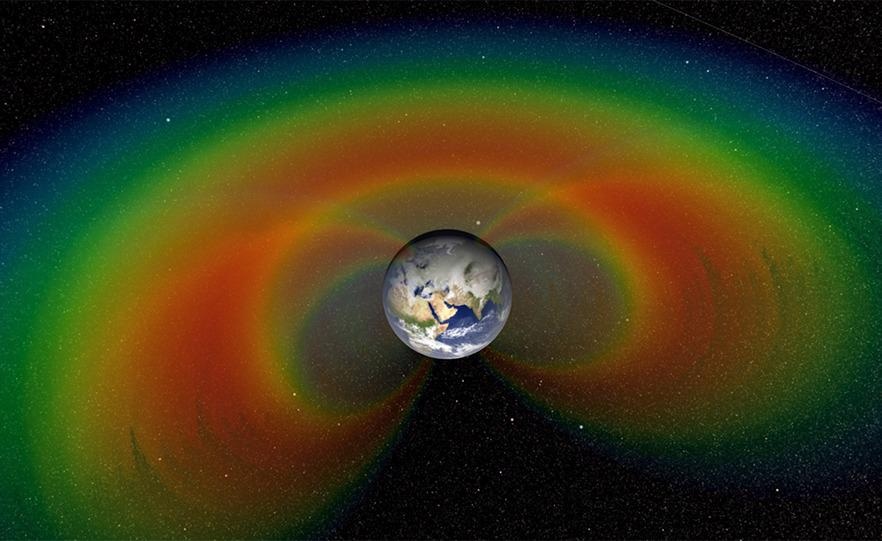May 27 2021
Very small charged protons and electrons, which can impair satellites and modify the ozone, have disclosed some of their enigmas to scientists from the University of Otago.
 An artist’s depiction with a cutaway section of the two giant donuts of radiation, called the Van Allen Belts, that surround Earth. Image Credit: NASA/Goddard Space Flight Center/Scientific Visualization Studio.
An artist’s depiction with a cutaway section of the two giant donuts of radiation, called the Van Allen Belts, that surround Earth. Image Credit: NASA/Goddard Space Flight Center/Scientific Visualization Studio.
In a research work, published in the Geophysical Research Letters journal, the researchers looked at charged particles that interact with a form of radio wave known as “EMIC”—a wave produced in Earth’s radiation belts, which are imperceptible rings of charged particles revolving the Earth.
According to the study lead author Dr Aaron Hendry from the Department of Physics, it is crucial to interpret how these waves influence the Earth’s climate as well as the belts—which are filled with significant and costly satellites.
Much like the Earth’s atmosphere, the Earth’s magnetosphere—the region around the Earth where our magnetic field is stronger than the Sun’s—sometimes experiences strong ‘storms’, or periods of high activity. These storms can cause significant changes to the number of particles in the radiation belts and can accelerate some of them to very high speeds, making them a danger to our satellites.
Dr Aaron Hendry, Study Lead Author, Department of Physics, University of Otago
“Knowing how many of these particles there are, as well as how fast they're moving, is very important to us, so that we can make sure our satellites keep working. Activity within the radiation belts can sometimes cause the orbits of these particles to change. If these changes bring the particles low enough to reach the Earth’s upper atmosphere, they can hit the dense air, lose all of their energy and fall out of orbit,” added Dr Hendry.
EMIC waves are known to be able to cause these changes and drive the loss of particles from the radiation belts. As well as causing beautiful light displays that we call aurora, this rain of particles can also cause complex chemical changes to the upper atmosphere that can, in turn, cause small, but important, changes in the amount of ozone present in atmosphere.
Dr Aaron Hendry, Study Lead Author, Department of Physics, University of Otago
“Although these changes are small, understanding them is very important to properly understanding how the chemistry of the atmosphere works, how it is changing over time, and the impact it is having on the climate,” added Dr Hendry.
In their new analysis, the investigators utilized the data obtained from GPS satellites to look at the number of electrons that can be knocked into the Earth’s atmosphere by EMIC waves.
A common rule in the radiation belts is that many more electrons will exist at slower speeds. Therefore, if the least speed of the EMIC wave interaction is reduced, there will be plenty of additional electrons around to interact with the EMIC waves.
By analyzing the information from satellites that track the number of electrons present in the radiation belts and the speed at which they travel, the team was able to demonstrate that the number of electrons in the radiation belts will reduce considerably when EMIC waves are around.
Excitingly, we have also seen changes in the number of electrons at speeds significantly lower than the current ‘accepted’ minimum speed. This means that EMIC can affect much larger numbers of electrons than we previously thought possible. Clearly, we need to rethink how we’re modelling this interaction, and the impact it has on the radiation belts. There are a lot of electrons in the radiation belts, so being able to knock enough of them into the atmosphere to make a noticeable change is quite remarkable.
Dr Aaron Hendry, Study Lead Author, Department of Physics, University of Otago
“This has shown that we need to take these EMIC waves into account when we're thinking about how the radiation belts change over time, and how these changes in the radiation belt affect the climate on Earth,” he further added.
According to Dr Hendry, the effect of EMIC-driven electrons on atmospheric chemistry is not being included in leading climate models, which attempt to estimate how the climate of Earth will vary over time; hence ensuring that this process is clearly understood and considered in these climate models is very crucial.
“The changes are very small compared to things like the human impact on climate, but we need to understand the whole picture in order to properly understand how everything fits together,” concluded Dr Hendry.
Journal Reference:
Hendry, A. T., et al. (2021) Evidence of Sub-MeV EMIC-Driven Trapped Electron Flux Dropouts From GPS Observations. Geophysical Research Letters. doi.org/10.1029/2021GL092664.